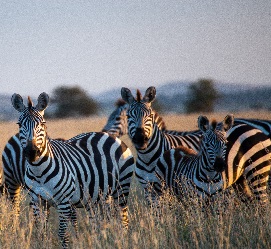African Wildlife Safaris in Tanzania tours is an overland journeys to observe wildlife safaris. Explore African Wildlife Safaris in Tanzania tours, especially in northern Tanzania safari tours with Tanzania Natural Tours.
Book nowBook Tanzania travel safari tours to Serengeti national park with Tanzania Natural Tours. Serengeti National Park is a large national park in northern Tanzania that stretches over 14,763 km2 (5,700 sq mi). It is located entirely in the eastern Mara Region and northeast portion of the Simiyu Region and contains over 15,000,000 hectares (37,000,000 acres) of virgin savanna. Serengeti is well known for the largest annual animal migration in the world of over 1.5 million blue wildebeest and 250,000 zebra and the largest lion population in Africa.
African Wildlife Safaris to Ngorongoro crater is the best Tanzania safari tours to Ngorongoro crater. Ngorongoro Crater has big 5 games such as elephant, lion, leopard, buffalo, and rhino. Huge herds of wildebeests and zebras traverse its plains during their annual migration in your African Wildlife Safaris in Tanzania tours. Livestock belonging to the semi-nomadic Maasai tribe graze alongside wild animals. Hominin fossils found in the Olduvai Gorge date back millions of years.
Enjoy African Wildlife tours in Tanzania to Lake Manyara. Manyara National Park is a protected area in Tanzania's Arusha and Manyara Regions, situated between Lake Manyara and the Great Rift Valley. It is administered by the Tanzania National Parks Authority and covers an area of 325 km2 (125 sq mi) including about 230 km2 (89 sq mi) lake surface. More than 350 bird species have been observed on the lake.
Trave with Tanzania Natural Tours in your Tanzania safaris tour trips to Tarangire National Park. Tarangire National Park is a national park in Tanzania's Manyara Region. The name of the park originates from the Tarangire River that crosses the park. The Tarangire River is the primary source of freshwater for wild animals in the Tarangire Ecosystem during the annual dry season. The Tarangire Ecosystem is defined by the long-distance migration of wildebeest and zebras. During the dry season, thousands of animals concentrate in Tarangire National Park from the surrounding wet-season dispersal and calving areas.
Tarangire National Park covers an area of approximately 2,850 square kilometers (1,100 square miles.) The landscape is composed of granitic ridges, river valleys, and swamps. Vegetation is a mix of Acacia woodland, Combretum woodland, seasonally flooded grassland, and baobab trees. Tarangire National Park is famous for its high density of elephants and baobab trees. Visitors to the park during June to November dry season can expect to see large herds of thousands of zebra, wildebeest, and cape buffalo. Other common resident animals include waterbuck, giraffe, dik-dik, impala, eland, Grant's gazelle, vervet monkey, banded mongoose, and olive baboon. Predators in Tarangire include lion, leopard, cheetah, caracal, honey badger, and African wildlife.
